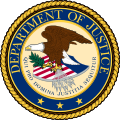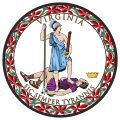Edmund Randolph
Edmund Randolph | |
|---|---|
 | |
| 1st United States Attorney General | |
| In office 26 September 1789 – 26 January 1794 | |
| Preceded by | none |
| Succeeded by | William Bradford |
| 2nd United States Secretary of State | |
| In office 2 January 1794 – 20 August 1795 | |
| Preceded by | Thomas Jefferson |
| Succeeded by | Timothy Pickering |
| Personal details | |
| Born | 10 August 1753 Williamsburg, Virginia |
| Died | 12 September 1813 Millwood, Virginia |
Edmund Jennings Randolph (August 10, 1753 – September 12, 1813) was an American attorney, Governor of Virginia, Secretary of State, and the first United States Attorney General.
Randolph was born August 10, 1753 to the prominent colonial Randolph family in Williamsburg, Virginia, and he was educated at the College of William and Mary. After graduation he began reading law with his father John Randolph and uncle, Peyton Randolph. In 1775, with the start of the American Revolution, his father remained a Loyalist and returned to Britain; Edmund Randolph remained in America where he joined the Continental Army as aide-de-camp to General George Washington.
Upon the death of his uncle Peyton Randolph in October of 1775 he returned to Virginia to act as executor of the estate, and while there was elected as a representative to the Virginia Convention. He would go on to serve as mayor of Williamsburg, and then as the first Attorney General of Virginia under the newly-formed state government.
Randolph was selected as a delegate to the Continental Congress in 1779, and served there to 1782. During this period he also remained in private law practice, handling numerous legal issues for George Washington among others.
Randolph was elected Governor of Virginia in 1786, that same year leading a delegation to the Annapolis Convention. The following year, as a delegate to the Constitutional Convention, he introduced the Virginia Plan as an outline for a new national government. He argued against importation of slaves and in favor of a strong central government, advocating a plan for three chief executives from various parts of the country. The Virginia Plan also proposed two houses, where in both of them delegates were chosen based on state population. He was also a member of the "committee on detail" which was tasked with converting the Virginia Plan's 15 resolutions into a first draft of the Constitution. Randolph, however, refused to sign the final document, believing the form of government it would engender had insufficient checks and balances, and published an account of his objections in October 1787. He nevertheless urged its ratification in 1788, seeing its adoption as necessary at that point.
He was appointed as the first U.S. Attorney General in September 1789, maintaining precarious neutrality in the feud between Thomas Jefferson (of whom Randolph was a distant relative) and Alexander Hamilton. When Jefferson resigned as Secretary of State in 1793, Randolph succeeded him to the position. In this post he held similar strict neutrality between the interests of France and Britain, earning the scorn of both in the process.
Randolph set forth the guidelines for John Jay's mission to London in 1794. These were, however, ignored. The resulting Jay's Treaty left Randolph to mollify, or calm, both France and the Federalists; in this he was largely unsuccessful.
Near the end of his term as Secretary of State, negotiations for Pinckney's Treaty were finalized.
A scandal involving an intercepted French message implying Randolph was prone to bribery led to his resignation in August 1795, although the allegations were provably unfounded.
After leaving the cabinet he returned to Virginia to practice law; his most famous case was that of defense counsel during Aaron Burr's trial for treason in 1807.
Randolph died on September 13, 1813 while visiting the home of a friend, Nathaniel Burwell of Carter Hall, near Millwood, Virginia in Clarke County and is buried at a nearby Burwell family cemetery "Old Chapel".





